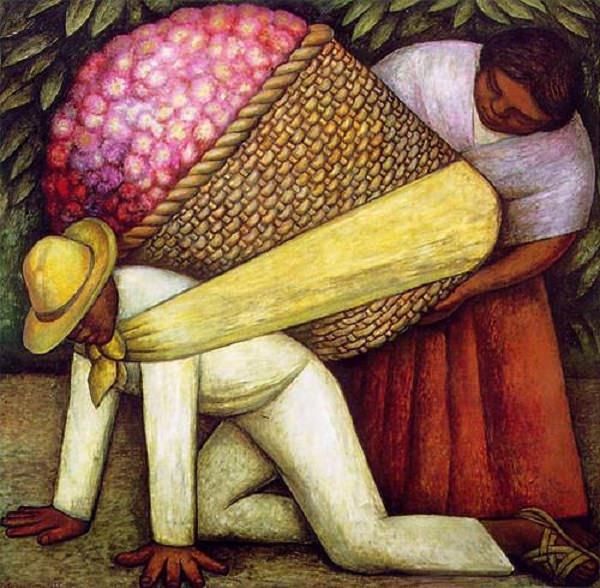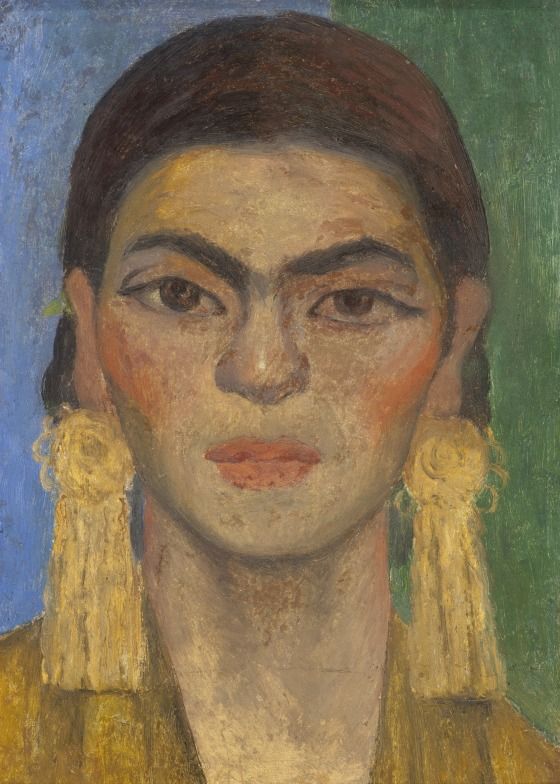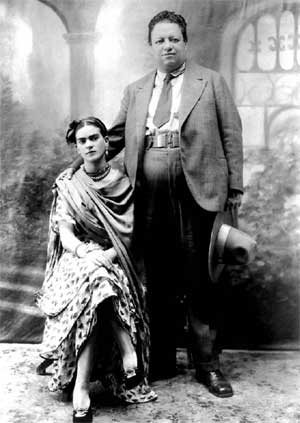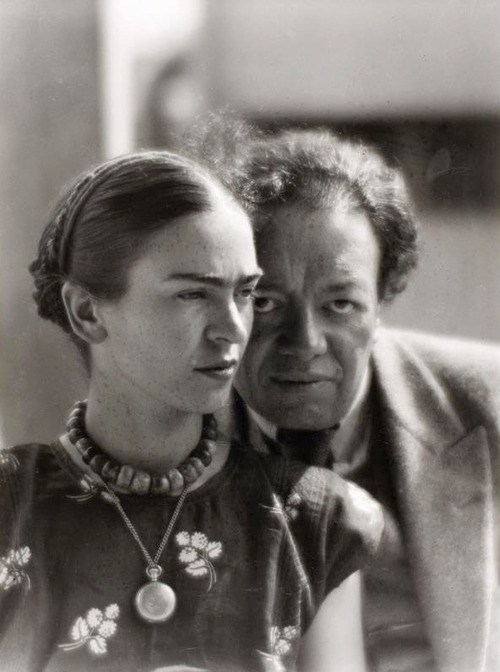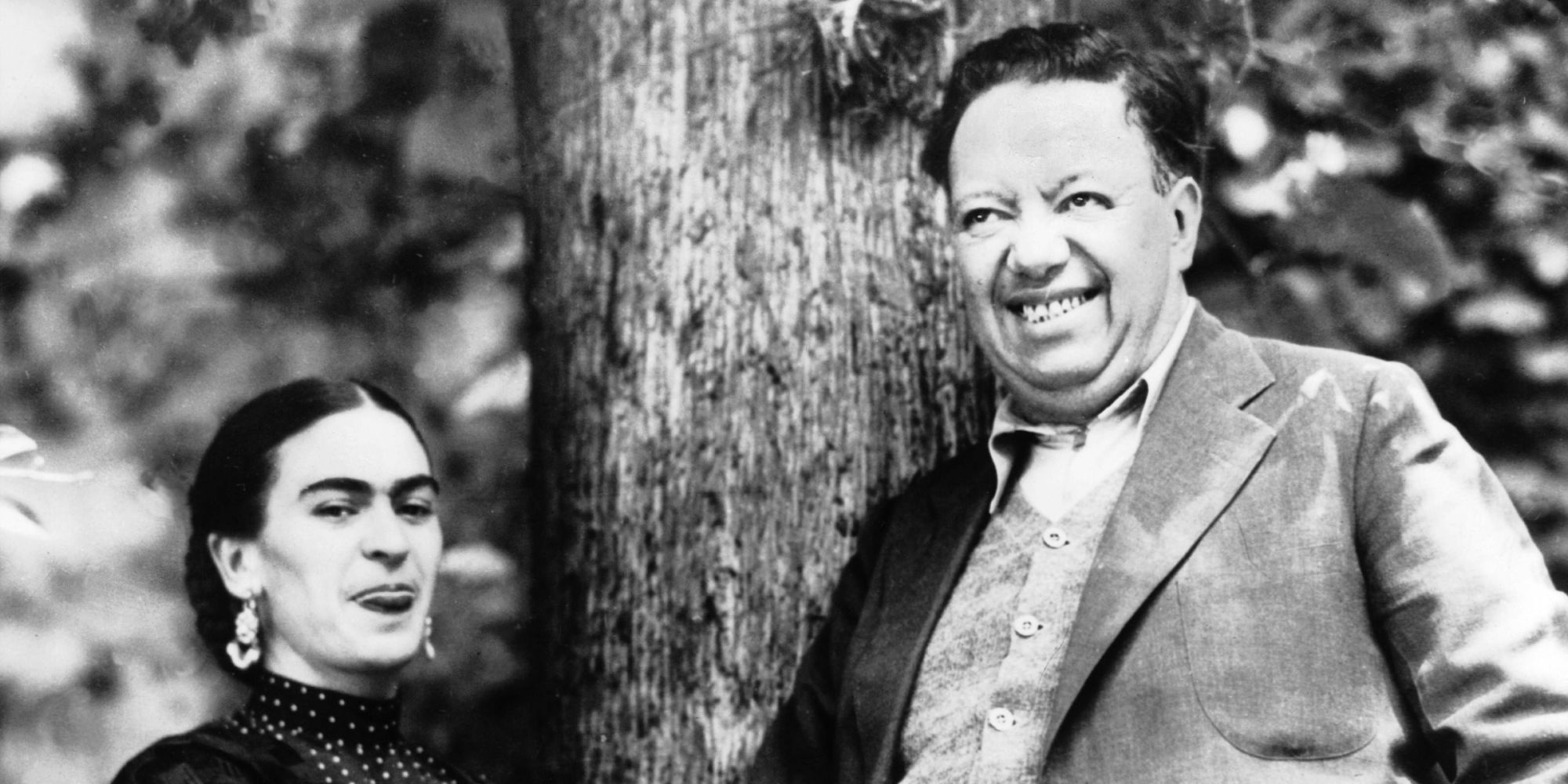Episode #12: Diego and Frida, Part 1
There’s something a little strange about the pairing of Frida Kahlo and Diego Rivera. Certainly it’s the surprise of a pairing of seeming opposites, at least from a physical standpoint-- she the small, seductive, and somewhat frail painter whose subject matter referred to the most intimate sides of her own life; he, the large and somewhat brutish muralist whose large-scale works touched upon revolution and justice and larger issues of Mexican history. There’s almost a Beauty and the Beast quality there, and for many of us, the relationship between these two artists is just as intriguing as their creative output. And especially when it comes to Frida’s art, it’s very hard to separate their love from their artistic legacy. But how did it begin? And what is it about these two that makes them so fascinating, even 60 years later?
Please SUBSCRIBE and REVIEW our show on Apple Podcasts!
Recommended Reading
Please note that ArtCurious is a participant in the Bookshop.org Affiliate Program, an affiliate advertising program designed to provide a means for sites to earn advertising fees by advertising and linking to bookshop.org. This is all done at no cost to you, and serves as a means to help our show and independent bookstores. Click on the list below and thank you for your purchases!
Episode Transcript
Jewelry and flowers, chocolates and conversation hearts, and let’s not forget the unattainable dinner reservations: you guessed it, Valentine’s Day is nearly upon us. As we approach February, it seems that romance is all around us-- or at least the capitalist version of it. Our love stories today seem like they are played out in TV commercials complete with artsy camera angles and swelling orchestras that do little to reflect the messiness of real relationships. Love is wonderful-- and complicated. But we don’t want to show this side of it. We want to hide the problems, the fights, the makeups, the drudgery of daily life. And social media allows us to do it easily, right? Well, how refreshing is it when someone actually speaks up and acknowledges that their love story isn't picture-perfect? Well, if you like that idea, how incredible must it have been, then, to see one magnetic couple’s intense love story played out in some of the most fascinating paintings of the twentieth century?
Sometimes people think that visual art is dry, boring, lifeless. They might remember childhood field trips to museums stuffed with cranky old women, deathly silent galleries, and dusty golden frames hanging on the wall. But sometimes, the stories behind those paintings, sculptures, drawings and photographs are weirder, crazier, or more fun than you can imagine. Art History is full of murder, intrigue, feisty women, rebellious men, crime, insanity, and so much more. And today, in celebration of the approaching Valentine’s Day holiday, we’ll have the first of two episodes exploring the epic love story of Diego Rivera and Frida Kahlo. Exploring the unexpected, the slightly odd, and the strangely wonderful in Art History, this is the ArtCurious Podcast. I'm Jennifer Dasal.
There’s something a little strange about the pairing of Frida Kahlo and Diego Rivera. Certainly it’s the surprise of a pairing of seeming opposites, at least from a physical standpoint-- she the small, seductive, and somewhat frail painter whose subject matter referred to the most intimate sides of her own life; he, the large and somewhat brutish muralist whose large-scale works touched upon revolution and justice and larger issues of Mexican history. There’s almost a Beauty and the Beast quality there, and for many of us, the relationship between these two artists is just as intriguing as their creative output. And especially when it comes to Frida’s art, it’s very hard to separate their love from their artistic legacy. But how did it begin? And what is it about these two that makes them so fascinating, even 60 years later?
Luckily, we are able to get the story directly from the horse’s mouth-- and I mean that with no disrespect to Mr. Rivera. One of my favorite things as a curator and an art historian is the opportunity to be able to hear about an artist’s work and life directly from the source. It’s a benefit that, for me, is indispensable. Even if much of it is heavily edited or more prone towards marketing, it’s still a fantastic way to get into the mindset of a singularly important creative individual. Luckily for us, we have a great resource in Rivera’s autobiography, titled My Art, My Life: An Autobiography, which was published three years after his death and was based on interviews that he gave to journalist Gladys March over a thirteen year period prior to his death in 1947.
According to Diego’s autobiography, he first met Frida when she was just a teenager-- many years before he would find her again and fall in love with her. When reading his description of these first encounters with Frida, the reader is struck by an overwhelming sense that something bigger was at play in bringing them together-- fate, destiny, the gods. In his reminiscences, Diego himself seems surprised-- flummoxed, even-- that this precocious and prankish girl would eventually become his wife, and the love of his life.
The momentous meeting occurred in 1922, when Diego Rivera had received a job to paint his first important mural, titled Creation, which was His very first governmental commission. Large and Italianate, filled with mythological, religious and symbolic figures- but no politically-affiliated ones, interestingly enough- The mural was to be a crowning display in the Bolivar lecture hall of the National Preparatory School in the center of Mexico City. The school was a rather prestigious institution, one of the oldest in the city, and at that time, only 35 girls were allowed to study there, out of a total of around 2,000 students. One of those 35 girls found delight in pranking Diego while he toiled for months, shouting to him while his back was turned and hiding herself away. But one night, the pranks stopped, and something entirely different occurred. While he was painting away in the company of his second wife, Lupe, he heard a commotion at the auditorium door as several students pushed against it. And then the magic happened. I’ll let Diego’s words speak for themselves here.
About this night, he said, QUOTE, “All at once the door flew open, and a girl who seemed to be no more than ten or twelve was propelled inside. She was dressed like any other high school student but her manner immediately set her apart. She had unusual dignity and self-assurance, and there was a strange fire in her eyes. Her beauty was that of a child, yet she was well developed. She looked straight up at me. “Would it cause you any annoyance if I watched you at work?” she asked. “No, young lady, I’d be charmed,” I said. She sat down and watched me silently, her eyes riveted on every move of my paint brush. After a few hours, Lupe’s jealousy was aroused, and she began to insult the girl. But the girl paid no attention to her. This, of course, enraged Lupe the more. Hands on hips, Lupe walked toward the girl and confronted her belligerently. The girl merely stiffened and returned Lupe’s stare without a word. Visibly amazed, Lupe glared at her a long time, then smiled, and in a tone of grudging admiration, said to me, “Look at that girl! Small as she is, she does not fear a tall, strong woman like me. I really like her.” The girl stayed about three hours. When she left, she said only, “Good night.” A year later I learned that her name was Frida Kahlo. But I had no idea that she would one day be my wife.”
One small point of correction here. Diego identified his future wife as looking to be about ten or twelve years old at the time. She was actually closer to fifteen years old, but as a small point of fact, Frida Kahlo’s age is kinda murky. She was born in 1907, but later, around the same time that she met Diego at the National Preparatory School, she got involved with a Mexican nationalist slash socialist group called Los Cachuchas, and in order to align herself more clearly and symbolically with their mission, Frida began claiming that she was actually born in 1910, the same year as the start of the Mexican Revolution. This causes confusion in the chronology of both her life and her art, and it is also possible that Diego did not know Frida’s correct age, so his assumption that she was around 12 years old could have felt correct to him, given her claims of a 1910 birth year.
So who was this child who charmed Diego and impressed his wife? She was born Magdalena Carmen Frida Kahlo y Calderón on July 6, 1907 in Coyoacán, a small village on the outskirts of Mexico City. It appears that she didn't have the best childhood, with a mother whom she would later describe as QUOTE "kind, active and intelligent, but also calculating, cruel and fanatically religious.” And then came a major blow. When Kahlo was just six years old, she contracted polio, and such an intense illness meant that she was unable to go to school and was isolated from other children of the same age. It also affected the growth of her legs, causing her right leg to be shorter and thinner than the left. As a result, once she had recovered and returned to school, she was harshly bullied by other children, who would frequently jeer at her and call her Peg-Leg Frida.
There was a silver lining, though. Like Andy Warhol, Frida’s absence from school life bonded her more closely to one of her parents. In her case, this was her father, who lavished extra care and attention on his sick daughter and, along the way, taught her about painting and photography--as he was a working photographer himself. Though Frida may not have known it at the time, this exposure to art proved to be life-changing.
Diego Rivera was born in Guanajuato, Mexico, to a fairly well-off family, on December 8, 1886, alongside his twin brother, Carlos. When the twins were nearly two years old, Carlos unexpectedly died, leaving Diego alone. As a coping mechanism, not too long after, Diego began drawing- as he later wrote, quote, “Just as soon as I could get my short little fat fingers around a pencil, I was drawing on everything.” When his parents caught him scribbling all over the walls of their home, they didn't scold him and instead lined their walls with canvas and chalkboards. Though no one could have known it at the time, the Rivera family essentially set their son up for success as one of the most important Mexican artists of the 20th century.
Diego began seriously studying art once he turned ten years old, attending the Academy of San Carlos in Mexico City. From all accounts, Diego was so good that his works caught wide attention locally, and he was rewarded for it six years later when, at his graduation, he was awarded a sponsorship to study art in Europe, paid for by none other than the governor of the State of Veracruz himself. With this, Diego Rivera began a nearly 14-year-long stint living in Europe. He started off in Madrid in 1907 before moving on to Paris, and it was there that he really found his niche, becoming fast friends with Amadeo Modigliani and Chaim Soutine and falling under the spell of works by Pablo Picasso, George Braque, and others. Diego himself became a Cubist painter for a while to limited success, but it wasn’t until he returned to Mexico in 1921, after both the Mexican and Russian revolutions made international waves, that he found his true style. He had been inspired by the Renaissance frescoes he had admired while touring Italy, and found the idea of a mural to be democratic-- something accessible to both the working class and native peoples of Mexico, not hidden away in some wealthy person’s drawing room. And thus, with a clear idea about presenting and celebrating Mexican history and heritage, Rivera’s first commissions began to pour in and he became a rising star in the art world.
Things weren’t going so well for Frida in the mid-1920s, though. In late 1925, when she was eighteen years old, Frida was riding a bus home from school when it collided with a street car, killing several people and seriously injuring several more, including Frida herself. In fact, Frida’s injuries were so serious that they were considered near-fatal, and it wasn't a given that she was going to make it. She had fractured ribs, a broken collarbone, and both legs had significant fractures as well. But the worst injury is horribly gruesome-- a handrail impaled her through her pelvis, fracturing it as well. She spent months recovering, both at the hospital and at home on bed rest, but the repercussions of such a significant accident would haunt her (and Diego, too) for the rest of her life. To cope, she had an easel fashioned at her bedside so that she could pass the time with art. Above the easel, a mirror was placed-- and Frida began creating her very first self-portraits, the subject which she is remembered most for today.
There’s something about the paintings of Frida Kahlo. Something deeper, mystical even. But one of the things that I love most about them, being an art historian, is that Frida obviously knows her own art history. Her early portraits of herself and her family reminds one of Renaissance artists, especially Botticelli and Bronzino, and she was influenced too by Cubism and other avant-garde movements. And these influences would serve her well while she developed and perfected her very own artistic style.
In 1927, two full years after the accident, Frida was deemed sufficiently recovered enough to rejoin society, so to speak. She immediately returned to her old school interests of politics and activism and joined the Mexican Communist Party immediately. At a party mixer a few months later, the photographer Tina Modotti introduced Frida to another artist who had become a star figure within the Mexican Communist Party while also becoming one of the most prominent artists in the country. His name, of course, was Diego Rivera.
Diego himself remembered things differently. In his autobiography he neglects to tell the story of their reintroduction at the Communist Party mixer, and instead jumps forward to a few weeks later, when their next dalliance echoed their original meeting in 1922. As Diego recalled it, quote, “I was at work on one of the uppermost frescoes at the Ministry of Education building one day, when I heard a girl shouting up to me, “Diego, please come down from there! I have something important to discuss with you!” I turned my head and looked down from my scaffold. On the ground beneath me stood a girl of about eighteen. She had a fine nervous body, topped by a delicate face. Her hair was long; dark and thick eyebrows met above her nose. They seemed like the wings of a blackbird, their black arches framing two extraordinary brown eyes.”
Frida, for her part, was all business. She had come not to flirt, but to ask Diego for his artistic opinion about her works. Every ounce that same feisty girl that she was at 15, she told him, quote, “I didn’t come here for fun. I have to work to earn my livelihood. I have done some paintings which I want you to look over professionally. I want an absolutely straightforward opinion, because I cannot afford to go on just to appease my vanity. I want you to tell me whether you think I can become a good enough artist to make it worth my while to go on. I’ve brought three of my paintings here. Will you come and look at them?”
Naturally, Diego agreed, and proceeded to study and admire Frida’s paintings. He later wrote about them, quote, “They showed none of the tricks in the name of originality that usually mark the work of ambitious beginners. They had a fundamental plastic honesty, and an artistic personality of their own. It was obvious to me that this girl was an authentic artist.” When he started giving Frida his overwhelmingly positive view of her work, she stiffened and apparently cut him off rather harshly for two conjoined reasons-- first, Frida was familiar with Diego’s work, but also with his reputation, which was that of an admitted womanizer. Second, Frida herself was beautiful and truly magnetic, and so was rather used to sycophantic behavior. Basically, she didn’t want Diego to be blowing smoke just because she was pretty. So she told him, quote, “I have not come looking for compliments. I want the criticism of a serious man.” Diego was undoubtedly taken aback. But he was also smitten by her ferocity and ambition. So, he agreed to meet with her one more time a few days later in order to give his sincere opinions about the rest of her paintings. When he arrived at her home, Frida took him from room to room, touring him through her house and to her paintings with joy and an effervescent spirit. Diego, by then, was already falling in love. He later said, quote, “I did not know it then, but Frida had already become the most important fact in my life. And she would continue to be, up to the moment she died, twenty-seven years later.”
Thus, the relationship between Diego and Frida began in earnest, with a passion that culminated in their marriage on August 21st, 1929, in a civil ceremony performed by the Mayor of one of Mexico City’s boroughs, who called the marriage a quote “historical event.” And indeed, the two experienced a sincere level of celebrity, especially as the 1930s progressed. It was a true meeting of the minds when these two artists married, to be sure--especially when Diego himself had gained a level of success and popularity. But public interest in them as a couple was also because, well, frankly, theirs was an odd pairing. He was middle-aged, over six feet tall, already divorced and weighed in at around 300 pounds. She, by contrast, was barely out of school, only about 5 foot 3, and weighing in at under 100 pounds. He was hearty, she was frail. According to author Hayden Herrera in her biography of Frida, Frida’s own parents were flummoxed by the union initially, calling it quote “a marriage between an elephant and a dove.” But they relented, because Frida’s father felt that Diego’s success in the arts would assure that he could afford to pay for his new wife’s ongoing medical needs.
Life for the newlyweds began as happily as could be. Soon after their marriage, they moved to the nearby city of Cuernavaca, about an hour’s drive south of Mexico City. Diego had received a mural commission there for the nearby Palace of Cortes, And while living in Cuernavaca with Diego, Frida began to fully come into her own in terms of her personal and artistic identity. Though she was always fascinated with Mexican history and culture, she sought to align herself even more closely with her heritage by wearing traditional or indigenous Mexican clothing, long, brightly colored skirts, huge headdresses, and lots and lots of jewelry. This appealed to Diego, who supported her nationalist aims, and made her stand out as a member of the artistic and intellectual crowd gaining political prominence in the capital. But it also had a good side-effect, too-- it effectively hid her injuries and the damages wrought by her terrible accident.
But the connection with her Mexican heritage didn’t stop at her appearance. It spread throughout and infused her artwork, too. Just as her own self became more decorated and colorful, so did her artwork, filled with bright bursts of pigment and relying heavily on symbols closely aligned not only with European Christian traditions, but also Mexican and Aztec history. Between the two of them, the couple came to represent the essence of Mexican culture in their work and themselves, particularly as they traveled away from Mexico for Diego’s work.
Their inherent “mexicanness,” (and I say that in air quotes), lent the couple an air of exoticism and glamour. In the early 1930s they lived primarily in America, moving first to San Francisco, where they were, according to Herrera,quote “feted, lionized, and spoiled” by the west coast cultural elite. While Diego completed murals for the San Francisco Stock Exchange, Frida herself participated in her very first art exhibition, showing a painting titled Frida and Diego Rivera at the Palace of the Legion of Honor. She didn’t typically call attention to her own art when she and Diego were mingling with his supporters and clients-- instead, she opted to play the little wife, and he was vastly proud to have this beauty at his side. Together they traveled, in a whirlwind of glittery flash-bulbs and media coverage, to New York, Detroit, Philadelphia, and back to New York again, with Diego creating some of his most iconic murals of his career, with high-profile commissions at the Detroit Institute of Arts and Rockefeller Center, the later of which would eventually be destroyed due to the artist’s refusal to paint over his depiction of Vladimir Lenin. As 1933 drifted to a close, the artists had been living outside of Mexico for the vast majority of over three years. Frida, especially, was ready for a change, and so before the new year of 1934, they headed back to Mexico City. And it was there that the situation for the couple began to vastly change. What was once a sparkling union between two captivating people became a disastrous union full of betrayal, lies, and revenge. In perhaps the most famous quip of her entire life, Frida Kahlo would later say, quote, “There have been two great accidents in my life. One was the trolley, and the other was Diego. Diego was by far the worst.”
But-- did she feel that way for the rest of her life? What happened next in their story might just surprise you.
Thank you for listening to this episode of the ArtCurious Podcast. This episode was written, produced, and narrated by me, Jennifer Dasal. Production assistance for the show is provided by Kaboonki Creative. K-A-B-Double O-N-K-I dot com. For images, information, and links to our previous episodes, please visit our website at artcuriouspodcast.com. And you can contact us via the website, email us at artcuriouspodcast@gmail.com, or find us on Twitter and Instagram at artcuriouspod.
I had so much fun writing this show today, as well as next week’s episode, and really got into the Valentine’s spirit-- so much so that we are offering a VERY special freebee to ArtCurious listeners. I worked with the amazing artist Kristin Smith to create special Diego and Frida valentines that you can download and share with your loved ones. Find them at www.artcuriouspodcast.com/valentines . And be sure to check out more of Kristin’s great stuff at her website, www.shipsandrobots.com. If you like this show, please consider donating to help offset the costs associated with keeping it going, and thanks to all of you who have already donated. Don’t forget, too, that if you don’t have any change to spare that you can support us just as importantly by leaving a review and rating on iTunes. It’s a huge help. Please check back with us in two weeks for the second half of our story on the epic romance between Diego Rivera and Frida Kahlo, as we continue to explore the unexpected, the slightly odd, and the strangely wonderful in art history.



